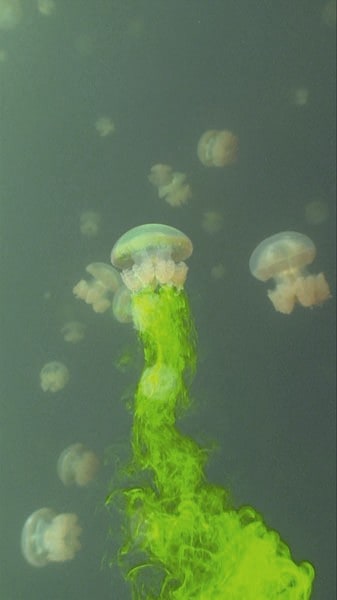
Darwin Year is now in full swing but the great evolutionary biologist was not the only member of the Darwin family to propose a scientific explanation for the behaviour of animals. His grandson — a British physicist, also called Charles — developed the novel idea that swimming marine life play a significant role in ocean mixing, an important process for distributing nutrients around the world’s oceans. Now, the Darwin family have yet another reason to celebrate this year, as a pair of researchers in California claim to have verified experimentally the theory of Charles Darwin Junior.
Fluid mixing processes are essential in the maintenance of global ocean circulation and they are also responsible for the transport of nutrients — a vital process in the marine ecosystem. Earth scientists have long-since agreed that this process is heavily influenced by atmospheric conditions, such as prevailing winds and heat exchange. However, for well over 100 years, some scientists have also argued that the action of fish swimming, when culminated over thousands of kilometres, could also have a part to play in the process.
Shake it like a seahorse
In the early 1950s Sir Charles Galton Darwin developed a physical model to explain how the movement of fish could be mixing the ocean. Darwin’s mechanism centred on the movement of fluid as fish swim vertically in a water column — marine animals are effectively dragging water with them as they swim up and down. As water pressure increases with depth, the swimming fish are continuously affecting the total potential energy of the fluid leading to further ambient fluid motions and eventually molecular mixing, claimed Darwin.
Partly because of inconclusive experimental results and partly because of the ongoing debates about atmospheric-ocean interaction, Darwin’s idea seemed to fall by the wayside in the mainstream research community. Fifty year later, however, Kakani Katija and John Dabiri at the California Institute of Technology say they have found firm experimental evidence to back up the idea of biogenic mixing. Enlisting the help of a team of scuba divers, the researchers captured the motion of jellyfish swimming vertically upwards from cold waters into warmer ones.
The major technical challenge was to capture the speed and direction of water when it is essentially transparent. By tracking the motion of particles suspended in the water, the researchers could determine how much kinetic energy an animal is injecting into the water as it swims. Particles were illuminated in a two-dimensional plane of the water and a video camera records the particle motion, in a process known as laser velocimetry. “For the divers the challenge is to control their body motions so that the camera is effectively stationary in the water, and so that the diver does not disturb the animals or the water around the animals being measured,” Dabiri told physicsworld.com.
Global mix
Another important challenge is to figure out how much Darwin’s mechanism could contribute to the overall process of ocean mixing. To do this, the researchers compare swimming efficiencies for the major marine species, with previous estimates of the total kinetic energy produced by turbulence in the wake of swimming fish. Publishing their findings in Nature, Katija and Dabiri suggest that ocean mixing due to Darwinian mixing is comparable with the global contribution of winds and tides.
“We expect to see Darwinian mixing in locations with large and dense aggregations of swimming animals that exhibit large vertical migrations. A candidate location is the Southern Ocean, where large communities of Antarctic krill perform these types of migrations,” said Dabiri.
Despite these new findings, it may still take further research for the idea to be fully accepted by the ocean science community. Eric Kunze, an ocean physicist at the University of Victoria in Canada explained that it has taken a long time to develop our current models of mixing caused by atmospheric conditions and there are still many unanswered questions. “The biological mixing mechanism appears to be even more challenging so I suspect it will be some time before we have an understanding of it,” he said.
The wider context of this research is the influence it could have on climate modelling. Amongst other effects, an increasing presence of presence of nutrients near the ocean surface could lead to algal blooms — a potential carbon sink. “An increase in one animal population can drive a decrease in another, and vice versa. Since not all animals will mix the ocean with the same efficacy, we must concern ourselves not only with the numbers of animals but also the species involved,” Dabiri told physicsworld.com.




